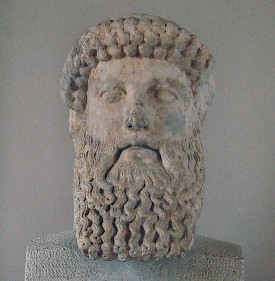Tenedos (Bozcaada)
Q211817Tenedos (Greek Τéνεδος): island opposite the coast of ancient Troy, modern Bozcaada.

The island of Tenedos is situated near Troy and controls the southwestern entrance of the Hellespont, from which it is about 20 kilometer away. It must have been more common for ships to wait on the beach of the little island until favorable winds allowed them to enter the Hellespont. That the site was well-suited for anchoring, is presumed in ancient legends, which tell that the Greeks went into hiding at Tenedos after leaving behind the Trojan horse.

The city of Tenedos is on the site of modern Bozcaada and had two harbors; from the sixth century BCE onward, it owned land on the opposite shore as well, which is only five kilometers away. The people spoke an Aeolian dialect resembling that of Lesbos, from which Tenedos was settled. Diodorus of Sicily attributes the foundation of the city to a man named Tenes, who came from Colone.note
 Tenedos, Corinthian phial |
 Tenedos, Corinthian pot. |
 Tenedos, Attic phial |
 Tenedos, Figurine of Cybele |

It was occupied by the Athenian commander Miltiades at the turn of the sixth/fifth century, conquered by the Persians after the Ionian Revolt, became a member of the Delian League, and was sacked by the Spartans during the Corinthian War (in 389 BCE). During Alexander's war against the Persian Empire, the Persian commander Pharnabazus occupied Tenedos an threatened the Alexander's line of communication; however, Pharnabazus was recalled.
Tenedos lost its independence and was added to Alexandria in Troas,note probably by Antigonus Monophthalmus in 306 BCE.
The Roman politician Cicero tells that the city had to pay heavily to the notorious senator Verres.note